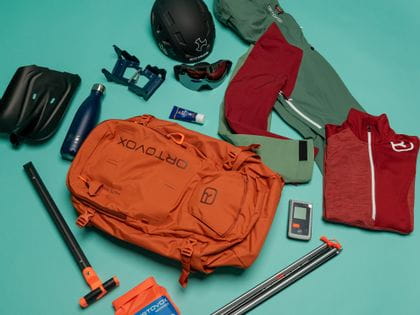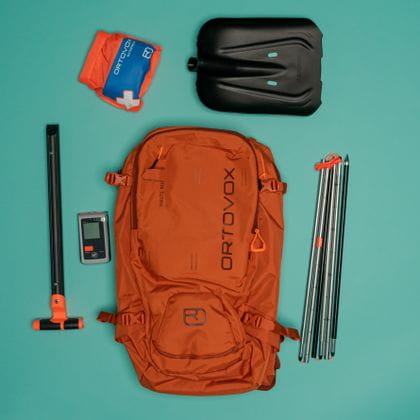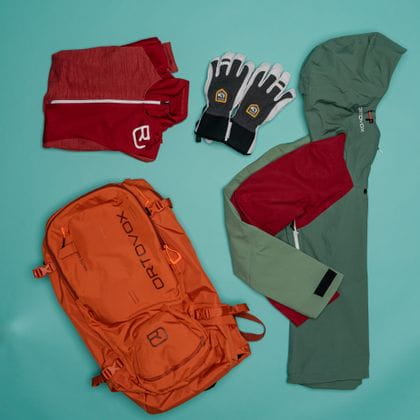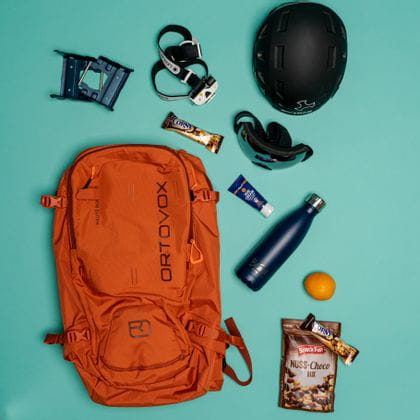Packing your ski touring rucksack - what do you need?
No ski touring fun - without the right equipment! I pack in my rucksack and take with me'...
The cold season is just around the corner and brings the ski touring season with it. Now it's time to pack your rucksack and off you go! But how do you do it properly and what do you really need on the mountain and what is just unnecessary ballast? We've taken a look at this for you so that you can go on tour fully equipped.

Emergency equipment
So that you are always safe on the go
What is necessary and should never be missing on a ski tour is, of course, safety and emergency equipment. Not only for you, but also so that you can help other tourers in an emergency. But what does this actually include?
Emergency equipment
- First aid kit & bivouac sack
- Probe, shovel & avalanche transceiver (MUST be worn on the body and is always switched on)
- Mobile phone with saved emergency number (140 in Austria)
- (If you use a smartphone, make sure that it is worn on your body or in a protected place in your rucksack. Otherwise you could have problems with the battery life. It is important that the distance from the avalanche transceiver is at least 30 cm).
What does not necessarily count as emergency equipment, but should always be with you, are crampons. If the conditions become more difficult (especially in the evening), you will be glad to have them, but you should also know how to use them.
A piece of wax or other coat care products can also be useful to have in your back pocket to prevent ‘studs’ on your coat.

Clothing
What do I actually need apart from the equipment I wear on the ascent?
Clothing
To prevent a cold, you should think about a change of clothes so that you don't get cold during the descent. This can really spoil your tour and your fun on the descent.
An additional warm layer (e.g. down jacket or a hard shell jacket) will keep you warm and will hardly weigh you down on the ascent.
You'll want to pack thin gloves for the ascent and thicker gloves for the descent. Ideally with windstopper or Gore-Tex. Don't forget your helmet and ski goggles, which you can attach to the outside of your rucksack or stow away in a helmet net, which many touring rucksacks come with.
What else do you need? Sun cream, sunglasses, headlamp, money and other small items should be adapted to your tour planning (evening ski tour etc.).
But don't forget, as little as possible, as much as necessary, is certainly not a useless motto here.

Food
Drinking enough before the tour saves you having to carry several water bottles, but even in cool temperatures you should not forget to take enough to drink with you. If you have a thermos flask of warm tea or something similar with you, this will not only keep you warm while you drink, but can also help against cold fingers.
If you have a hydration bladder in your rucksack, you should make sure the bladder and tube are insulated, otherwise they may freeze during the ascent. .
As far as snacks are concerned, it's up to you what you take with you on your tour. Whether it's a muesli bar, cheese roll or fruit - it should give you the right energy boost.

But how do I stow my seven things?
A rucksack with around 30 litres is enough for a normal day trip. Put your shovel and probe in the designated emergency compartment. You can stow your change of clothes at the bottom of the rucksack. The bivouac sack and first aid kit are best placed on top. At the top, place things that you need frequently and quickly, such as your water bottle, provisions, etc. If you have a rucksack that can be opened at the back, you can save yourself a lot of searching and have everything well organised. Finally, pack your small items in the zip compartment at the top.
If you go through this packing list step by step, you will not only be fully prepared, but you will also save yourself time and be prepared for any surprises. And now it's time to head for the mountains or wait until the conditions are right?